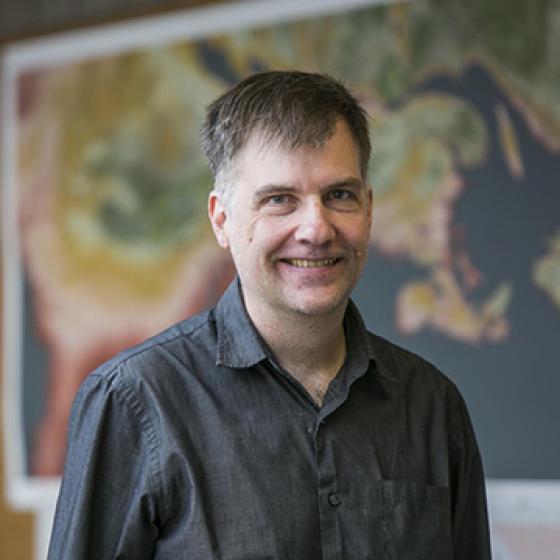
- Graduate Field Affiliations
- Aerospace Engineering
- Astronomy and Space Sciences
- Atmospheric Science
- Electrical and Computer Engineering
- Geological Sciences
Biography
David Hysell earned his Ph.D. from Cornell in 1992. Hysell investigates ionospheric plasma physics with a focus on plasma instabilities, ionospheric irregularities, and their effects on radio wave propagation. Communication outages caused by ionospheric irregularities are a central component of the National Space Weather Program. The instabilities of interest are found in the equatorial and auroral electrojets, in the midlatitude E region ionosphere, and in equatorial and midlatitude spread F. The research is both experimental and theoretical and has a substantial computational component. An important research tool for studying the equatorial ionosphere is the Jicamarca Radio Observatory near Lima, Peru, the world’s largest radar. In the spring of 2005, Hysell became the PI for the NSF Cooperative Agreement that supports Jicamarca.
Research Interests
The ionosphere and the instabilities and irregularities that inhabit it are mainly studied with remote sensing using radar. Processing and interpreting both kinds of signals turns out to be demanding, and conventional analysis techniques are fraught with artifacts and ambiguity. Hysell’s research focuses mainly on redefining the way radars are used to study the ionosphere and on improving closure between theory and experiment. As the radar techniques developed by Hysell’s group are often applicable in other disciplines, including commercial and defense-related fields, this work has overtones outside aeronomy. Much of Hysell’s research is conducted at the Jicamarca Radio Observatory, the world’s largest radar, located outside Lima, Peru. Jicamarca is owned by the Peruvian government but funded mainly through a cooperative agreement between the National Science Foundation and Cornell University. Hysell became the PI for the cooperative agreement in 2005, helping to maintain Cornell’s leadership in aeronomy, space physics, and radar remote sensing. Jicamarca provides an ideal environment for developing, prototyping, and testing new radar techniques, modes, and instrumentation. Once developed, Hysell strives to migrate new radar techniques to different geographic regions for wider application. The strategy is accomplished through the construction and deployment of portable radar systems to middle- and high-latitude sites (the Caribbean and Alaska in particular). These deployments make it possible to address a wide range of problems in aeronomy and to collaborate with different agencies and institutions. Much of the research is also suitable material for the classroom.
Teaching Interests
Hysell continues to teach EAS/ECE 4870, Introduction to Radar Remote Sensing, each year. Every other year, Hysell teaches EAS 4840/5840, Inverse Methods in the Natural Sciences. In between years, Hysell alternates between teaching an advanced radar course (EAS 5880) and courses on upper atmospheric physics. Hysell has also taught Introduction to Plasma Physics in ECE.
Select Publications
-
Hysell, D. L., Bui, M. X., & Larsen, M. F. (2024). “Observations and model of subauroral sporadic E layer irregularities driven by turning shears and dynamic instability.” Journal of Geophysical Research: Space Physics, 129, e2024JA033088.
-
Hysell, D. L., Kirchman, A., Harding, B. J., Heelis, R. A., England, S. L., Frey, H. U., & Mende, S. B. (2024). “Using ICON satellite data to forecast equatorial ionospheric instability throughout 2022.” Space Weather, 22, e2023SW003817.
-
Hysell, D. L., & Chau, J. L. (2023). “Aperture synthesis imaging of ionospheric irregularities using time diversity MIMO radar.” Radio Science, 58, e2023RS007765.
-
Hysell, D. L., & Rojas, E. (2023). “Modeling E-region artificial periodic inhomogeneity.” Radio Science, 58, e2023RS007710. https://doi.org/10.1029/2023RS007710
-
Hysell, D. L., Kirchman, A., Harding, B. J., Heelis, R. A., & England, S. L. (2023). “Forecasting equatorial ionospheric convective instability with ICON satellite measurements.” Space Weather, 21, e2023SW003427.
Select Awards and Honors
- American Geophysical Union Fellow 2024
- Waynick Distinguished Lecture 2019
- Sonny Yau Excellence in Teaching Award 2006
- CEDAR Prize Lecture Award 1999
- URSI Young Scientist Award 1996
- Radio Science Citation for Excellence in Refereeing 1996
Education
- B.S. (Electrical & Communication Engineering), Penn State University 1987
- Ph.D. (Electrical & Communication Engineering), Cornell University 1992

